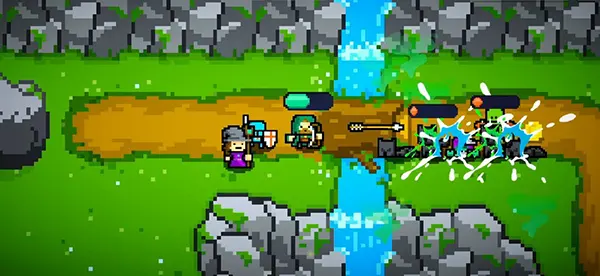MageTrain – A Roguelike Snake-Style Adventure Game
MageTrain is a fresh entry in the roguelike genre that smartly blends strategic spellcasting with the mechanics of the classic “Snake” arcade game. Developed by indie creators passionate about retro gameplay and magical worlds, this title has caught the attention of players on platforms like Steam and itch.io for its unique mechanics, minimalistic art style, and a replay value that keeps growing with every run. As of February 2025, MageTrain continues to gain a loyal fanbase due to its originality and tightly-tuned gameplay.
The Concept Behind MageTrain
At its core, MageTrain invites players to take control of a mage who travels through procedurally generated dungeons, collecting magical powers while growing a literal train of spells and artefacts behind them — much like the body of the snake in the original mobile game. The goal is to survive waves of enemies and environmental traps using the right spell combinations and movement patterns.
What sets MageTrain apart is its pacing and balance. Unlike many frantic roguelikes, it rewards strategic planning over twitch reflexes. Every spell you attach to your train affects the length, direction, and chain reactions during encounters. A misstep can block your path or activate a damaging spell at the wrong time, leading to clever risk-reward decision-making throughout the game.
With each new level, players face increasingly difficult layouts, tougher enemies, and tighter spaces — all of which make careful positioning and spell order vital. This adds a fresh level of depth to a nostalgic mechanic and sets MageTrain apart from its contemporaries.
Procedural Dungeons and Replayability
MageTrain’s procedurally generated dungeons ensure that no two runs are the same. Every session is a puzzle, with randomised enemy placements, loot drops, and terrain hazards. This variation compels players to adapt their strategies, avoiding repetition and enhancing long-term engagement.
Each new run offers a chance to experiment with different spell synergies. For instance, combining fire-based spells with explosive artefacts may lead to devastating effects in narrow hallways, while defensive spells can provide much-needed breathing room during overwhelming enemy waves.
The game also features a meta-progression system. Players can unlock new spell types, train skins, and special abilities by completing in-game challenges or achieving milestones. This unlock structure encourages experimentation and skill development over time.
Visual Style and Sound Design
MageTrain uses a pixel-art aesthetic that feels both retro and modern. The dungeons are filled with glowing glyphs, animated spell effects, and enemy designs that borrow from dark fantasy and mythological sources. This visual consistency gives the game a coherent identity while paying homage to classic titles.
Although the visuals are simple, the polish is notable. Particle effects, lighting cues, and UI animations enhance the experience without overwhelming the screen. The game’s minimalist art allows players to focus on the strategic layer of spell management and movement.
Complementing the visuals is a dynamic soundtrack composed of chiptune-infused orchestral scores. Sound effects provide clear feedback for every action — whether it’s picking up a spell, defeating an enemy, or taking damage. This clarity enhances gameplay comprehension, especially during chaotic encounters.
Accessibility and Platform Support
One of MageTrain’s strengths is its accessibility. The game supports both mouse-keyboard and gamepad setups, allowing smooth play across PCs, handheld devices, and streaming platforms like Steam Deck. As of early 2025, developers have confirmed plans to expand to Nintendo Switch, citing fan demand.
For newcomers, the tutorial offers a concise explanation of the game’s systems, while difficulty settings enable casual players and hardcore fans alike to find their sweet spot. The clean UI and intuitive spell assignment system reduce the learning curve significantly.
The developers have also made an effort to support community modding and translations, which has led to fan-made localisations in German, Spanish, and Japanese. This openness to player contributions has helped MageTrain flourish beyond English-speaking markets.

Game Mechanics and Spell System
The highlight of MageTrain’s gameplay is the spell-chain mechanic. Each spell attached to your mage’s train activates in sequence, reacting to your movement, position, or enemy actions. Some spells have area-of-effect properties, while others require timing or positioning to be effective.
Players must balance offensive, defensive, and utility spells. A poorly arranged train might result in wasted turns or even self-inflicted damage. Strategic planning before and during each level is essential to survival. Mastery comes from understanding how different spells interact and how to arrange them for maximum synergy.
Environmental interactions add another layer of challenge. Spells can trigger traps, break walls, or interact with elemental hazards. For example, water surfaces enhance lightning spells but neutralise fire-based attacks, making terrain awareness just as important as spell knowledge.
Community Feedback and Future Updates
The MageTrain community is active and supportive. Players regularly share spell setups, strategies, and fan art on platforms like Reddit and Discord. This sharing culture has helped the game stay vibrant long after its release.
As of February 2025, the developers have announced a forthcoming content update that introduces a new biome — the Crystal Catacombs — and a dozen new spells. They also hinted at a daily challenge mode and leaderboard system to expand competitive play.
Players appreciate the transparent development roadmap and quick bug fixes. MageTrain’s indie team maintains regular communication with the community, which has helped the game avoid many of the pitfalls of Early Access titles.
